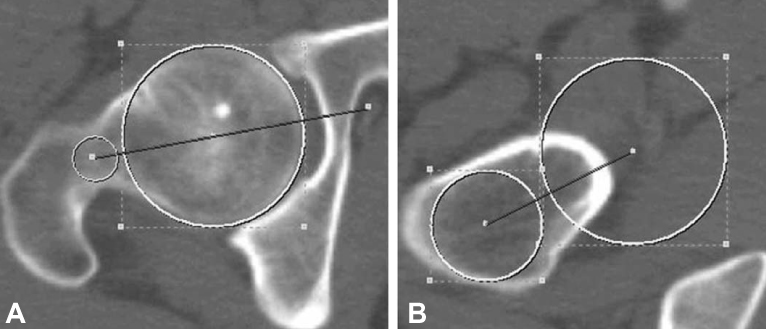J Korean Hip Soc.
2011 Mar;23(1):47-53. 10.5371/jkhs.2011.23.1.47.
Femoral Neck Anteversion Measured Using a 3D CT Scan Perpendicular to the Mechanical Axis of the Femur
- Affiliations
-
- 1Department of Orthopedic Surgery, College of Medicine, Konyang University, Daejeon, Korea. ajouos@hanmail.net
- 2Department of Orthopedic Surgery, College of Medicine, Yonsei University, Seoul, Korea.
- 3Department of Orthopedic Surgery, School of Medicine, Ajou University, Suwon, Korea.
- KMID: 2190775
- DOI: http://doi.org/10.5371/jkhs.2011.23.1.47
Abstract
- PURPOSE
We wanted to measure the femoral neck anteversion (FNA) angles using a 3D CT scan that perpendicularly cut the mechanical axis of the femur and to assess the accuracy and reproducibility of different measuring methods.
MATERIALS AND METHODS
We obtained 95 cases of 3D CT images of the cross-section perpendicular to the mechanical axis of the femur. The methods used to measure the FNA angles included a method using the CT image of the area where the femoral neck is confluent to the greater trochanter (method 1), a method using the CT image taken from the neck base immediately prior to the beginning of the area of the lesser trochanter (method 2) and a method by which measurements are made after putting 3D bone models on a horizontal plane in virtual space (method 3). The reference axes of the distal femur we used were the anatomical transepicondylar axis, the surgical transepicondylar axis and the real posterior condylar axis.
RESULTS
The FNA angles measured by method 1 were 4.79+/-6.41degrees to the anatomical transepicondylar axis (ATEA), 6.09+/-6.58degrees to the surgical transepicondylar axis (STEA) and 7.96+/-6.81degrees to the real posterior condylar axis (rPCA). The FNA angles measured by method 2 were 16.01+/-8.31degrees to the ATEA, 19.52+/-8.38degrees to the STEA and 21.79+/-8.52degrees to the rPCA. The FNA angles measured by method 3 were 20.15+/-12.89degrees to the rPCA.
CONCLUSION
The measurement of the FNA angle using a 3D CT scan perpendicular to the mechanical axis is reproducible. The measurement method on the neck base level is more reliable than the one on the proximal neck confluence, and more similar to the measurement method by classic definition.
Keyword
MeSH Terms
Figure
Reference
-
1. Kingsley PC, Olmsted KL. A study to determine the angle of anteversion of the neck of the femur. J Bone Joint Surg Am. 1948. 30A:745–751.
Article2. Kuo TY, Skedros JG, Bloebaum RD. Measurement of femoral anteversion by biplane radiography and computed tomography imaging: comparison with an anatomic reference. Invest Radiol. 2003. 38:221–229.
Article3. Billing L. Roentgen examination of the proximal femur end in children and adolescents; a standardized technique also suitable for determination of the collum-, anteversion-, and epiphyseal angles; a study of slipped epiphysis and coxa plana. Acta Radiol Suppl. 1954. 110:1–80.4. Weiner DS, Cook AJ, Hoyt WA Jr, Oravec CE. Computed tomography in the measurement of femoral anteversion. Orthopedics. 1978. 1:299–306.
Article5. Reikerås O, Bjerkreim I, Kolbenstvedt A. Anteversion of the acetabulum and femoral neck in normals and in patients with osteoarthritis of the hip. Acta Orthop Scand. 1983. 54:18–23.
Article6. Murphy SB, Simon SR, Kijewski PK, Wilkinson RH, Griscom NT. Femoral anteversion. J Bone Joint Surg Am. 1987. 69:1169–1176.
Article7. Sugano N, Noble PC, Kamaric E. A comparison of alternative methods of measuring femoral anteversion. J Comput Assist Tomogr. 1998. 22:610–614.
Article8. Lee YS, Oh SH, Seon JK, Song EK, Yoon TR. 3D femoral neck anteversion measurements based on the posterior femoral plane in ORTHODOC system. Med Biol Eng Comput. 2006. 44:895–906.
Article9. Kim JS, Park TS, Park SB, Kim JS, Kim IY, Kim SI. Measurement of femoral neck anteversion in 3D. Part 1: 3D imaging method. Med Biol Eng Comput. 2000. 38:603–609.
Article10. Kim JS, Park TS, Park SB, Kim JS, Kim IY, Kim SI. Measurement of femoral neck anteversion in 3D. Part 2: 3D modelling method. Med Biol Eng Comput. 2000. 38:610–616.
Article11. Hermann KL, Egund N. CT measurement of anteversion in the femoral neck. The influence of femur positioning. Acta Radiol. 1997. 38:527–532.12. Hernandez RJ, Tachdjian MO, Poznanski AK, Dias LS. CT determination of femoral torsion. AJR Am J Roentgenol. 1981. 137:97–101.
Article13. Dunn DM. Anteversion of the neck of the femur; a method of measurement. J Bone Joint Surg Br. 1952. 34-B:181–186.14. Edholm P. Nomogram for measuring the anteversion angle and angulation of fracture from roentgenograms. Acta Radiol Diagn (Stockh). 1972. 12:856–864.
Article15. Ryder CT, Crane L. Measuring femoral anteversion; the problem and a method. J Bone Joint Surg Am. 1953. 35-A:321–328.16. Henriksson L. Measurement of femoral neck anteversion and inclination. A radiographic study in children. Acta Orthop Scand Suppl. 1980. 186:1–59.
Article17. Backman S. The proximal end of the femur: investigations with special reference to the etiology of femoral neck fractures; anatomical studies; roentgen projections; theoretical stress calculations; experimental production of fractures. Acta Radiol Suppl. 1957. 146:1–166.18. Griffin FM, Insall JN, Scuderi GR. The posterior condylar angle in osteoarthritic knees. J Arthroplasty. 1998. 13:812–815.
Article19. Newbern DG, Faris PM, Ritter MA, Keating EM, Meding JB, Berend ME. A clinical comparison of patellar tracking using the transepicondylar axis and the posterior condylar axis. J Arthroplasty. 2006. 21:1141–1146.
Article
- Full Text Links
- Actions
-
Cited
- CITED
-
- Close
- Share
- Similar articles
-
- Comparative Study in the Femoral Anteversion measured by CT and MR Imaging as a PACS Image Viewer
- Measurement of Femoral Anteversion in the PACS Image Viewer
- The Availability of Radiological Measurement of Femoral Anteversion Angle: Three-Dimensional Computed Tomography Reconstruction
- Change of Femoral Anteversion during Closed Femoral Intramedullary Nailing
- Distal Femoral Rotational Alignment Based on Mechanical Axis of the Femur: A 3-Dimensional Computed Tomographic Scan in Vivo Assessment







